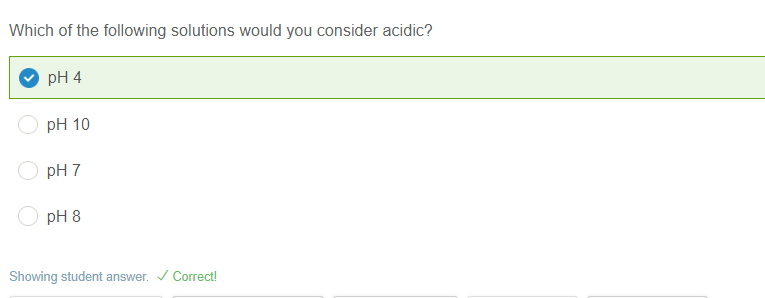QUESTIONS
Question 1
Which of the following solutions would you consider acidic?
- pH 4
- pH 7
- pH 8
- pH 10
Question 2
If you were to dissolve 2.5 grams of NaCL in 150g of water, I would call the NaCL the:
- Solute
- Solution
- Mixture
- Solvent
Question 3
I mix tow liquids together and shake them up. I see that I have microspcopic droplets of one liquid suspended in the other. I would call this
- Solute
- Mixture
- Solvent
- Emulsion
Question 4
Let us think back to our original cup of tea. We remove the teabag from the cup of tea pictured above. Do you think that this cup of tea is a homogenous or heterogeneous solution? Assume when the teabag is removed, no tea leaves remain in the cup.
- Homogenous
- Heterogenous
Question 5
Based on the characteristics in the table below, determine how you might classify each of these simple solutions by dragging each simple solution to the proper category.
| Classification | Distinguishing Characteristics | Example |
| Solution | Solute particles cannot be visually distinguished from solvent or one another. Cannot be separated by a membrane or by setting out. Usually transparent. | Saltwater |
| Colloidal Suspensions | Contains particles large enough to scatter light, and appear cloudy. Can be separated by a membrane but NOT by settling out. Often have gel like consistencies. | Silica nanoparticles in water |
| Emulsions | One liquid suspended, but not dissolved in another liquid. Often one liquid is water based and the other is old based. | Homogenous mixture of oil and water |
- Solutions
- Colloidal Suspensions
- Emulsions
Question 6
Buffers
Drag the outcomes to the correct beaker
Beaker 1: water
Beaker 2: phosphate buffered solution
Question 7
You have a mixture that consists of small droplets of olive oil suspended in another liquid. The mixture seems stable. I would call this mixture.
- Emulsion
- Solvent
- Solution
- Colloid
Question 8
Seven grams of a salt is dissolved in eight hundred ml of water. The water would be considered the:
- Colloid
- Mixture
- Solute
- Solvent
Question 9
You add a few drops of a strong acid to a beaker of liquid with a pH of 4.6. After you add the drops of strong acid, the pH remains 4.6. I would estimate that the liquid in the beaker as a:
- Buffer
- Emulsion
- Solvent
- Solution
Question 10
In a chemical reaction, H3PO4 reacts with another substance and becomes H2PO4-. Based on this, I would expect that this compound acted as;
- A base in this reaction
- A solution in this reaction
- An acid in this reaction
- A solute in this reaction.
Question 11
Which of the following is not a key property of water?
- Water is able is dissolve many substances
- Water molecules are able to stick to nearby molecules in a process known as cohesion.
- Water can participate in many chemical reactions.
- Water has a high heat capacity (ability to absorb heat)
Question 12
Select all the following solutions that would be expected pH values for basic solutions? Select all that apply.
- pH 9
- pH 7
- pH 10
- pH 12
- pH 5
ANSWERS
Question 1
Which of the following solutions would you consider acidic?
- pH 4
- pH 7
- pH 8
- pH 10

To access all answers, use the purchase button below.
